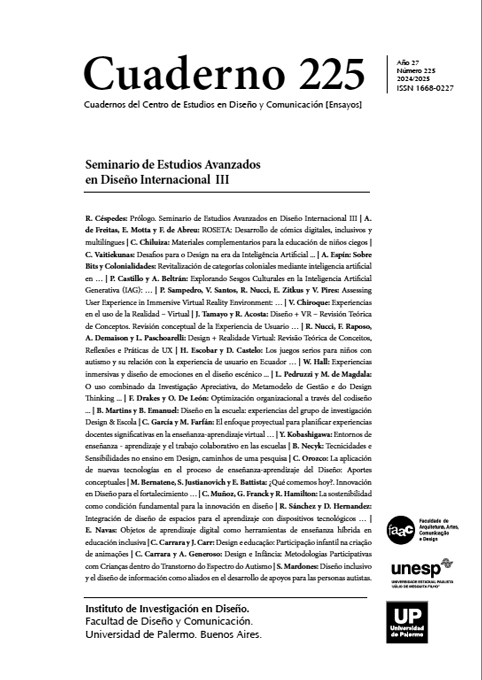Objetos de aprendizaje digital como herramientas de enseñanza híbrida en educación inclusiva
Abstract
This study, focused on integrating digital learning objects into hybrid teaching to facilitate inclusive education, employs a method of bibliographic review to analyze a variety of academic sources.
References
Billings, D. M. (2010). Using Reusable Learning Objects. The Journal of Continuing Education in Nursing, 41(2), 54–55. https://doi.org/10.3928/00220124-20100126-08
Cavanaugh, C., Freidhoff, J., & Ferdig, R. (2012). Lessons learned from blended programs: Experiences and recommendations from the field. iNACOL
Cortiella, C. (2016). The state of learning disabilities (Third, Issue October). National Center for Learning Disabilities.
Chen, B. H., & Chiou, H.-H. (2014). Learning style, sense of community and learning effectiveness in hybrid learning environment. Interactive Learning Environments, 22(4), 485–496. https://doi.org/10.1080/10494820.2012.680971
Cheung, S. K. S., Kwok, L., Yang, H., Fong, J., & Kwan, R. (2015). Hybrid Learning: Innovation in Educational Practices (Vol. 9167). Springer International Publishing. https://doi.org/10.1007/978-3-319-20621-9
Dodani, M. H. (2002). The Dark Side of Object Learning: Learning Objects. The Journal of Object Technology, 1(5), 37. https://doi.org/10.5381/jot.2002.1. 5.c3
Engzell, P., Frey, A., & Verhagen, M. D. (2021). Learning loss due to school closures during the COVID-19 pandemic. Proceedings of the National Academy of Sciences, 118(17). https://doi.org/10.1073/pnas.2022376118
Franklin, D. (2018). Helping your child with language-based learning disabilities: Strategies to succeed in school & life with dyslexia, dysgraphia, dyscalculia, ADHD & processing disorders. New Harbinger Publications.
Ferri, F., Grifoni, P., & Guzzo, T. (2020). Online learning and emergency remote teaching: Opportunities and challenges in emergency situations. Societies, 10(4). https://doi.org/10.3390/soc10040086
Grigorenko, E. L., Compton, D. L., Fuchs, L. S., Wagner, R. K., Willcutt, E. G., & Fletcher, J. M. (2020). Understanding, educating, and supporting children with specific learning disabilities: 50 years of science and practice. American Psychologist, 75(1), 37–51. https://doi.org/10.1037/amp0000452
Guenaga, M., Mechaca, I., Romero, S., & Eguíluz, A. (2012). A tool to evaluate the level of inclusion of digital learning objects. Procedia Computer Science, 14, 148–154. https://doi.org/10.1016/j.procs.2012.10.017
Hartono, S., Kosala, R., Supangkat, S. H., & Ranti, B. (2018). Smart Hybrid Learning Framework Based on Three-Layer Architecture to Bolster Up Education 4.0. 2018 International Conference on ICT for Smart Society (ICISS), 1–5. https://doi.org/10.1109/ICTSS.2018.8550028
Helms, S. A. (2014). Blended/hybrid courses: a review of the literature and recommendations for instructional designers and educators. Interactive Learning Environments, 22(6), 804–810. https://doi.org/10.1080/10494820.2012.745420
Hwang, A. (2018). Online and Hybrid Learning. Journal of Management Education, 42(4), 557–563. https://doi.org/10.1177/1052562918777550
Kalogiannakis, M., & Papadakis, S. (2017). Combining mobile technologies in environmental education: a Greek case study. International Journal of Mobile Learning and Organisation, 11(2), 108. https://doi.org/10.1504/IJMLO.2017.084272
Li, Q., Li, Z., & Han, J. (2021). A hybrid learning pedagogy for surmounting the challenges of the COVID-19 pandemic in the performing arts education. Education and Information Technologies, 26(6), 7635–7655. https://doi.org/10.1007/s10639-021-10612-1
Mettis, K., & Väljataga, T. (2021). Designing learning experiences for outdoor hybrid learning spaces. British Journal of Educational Technology, 52(1), 498–513. https://doi.org/10.1111/bjet.13034
Mooij, T. (2007). Design of educational and ICT conditions to integrate differences in learning: Contextual learning theory and a first transformation step in early education. Computers in Human Behavior, 23(3), 1499–1530. https://doi.org/10.1016/j.chb.2005.07.004
Norman, S., & Porter, D. (2007). Designing Learning Objects for online learning. Vancouver, BC,Canada: Knowledge Series.
Papastergiou, M., & Mastrogiannis, I. (2021). Design, development and evaluation of open interactive learning objects for secondary school physical education. Education and Information Technologies, 26(3), 2981–3007. https://doi.org/10.1007/s10639-020-10390-2
Poultsakis, S., Papadakis, S., Kalogiannakis, M., & Psycharis, S. (2021). The management of Digital Learning Objects of Natural Sciences and Digital Experiment Simulation Tools by teachers. Advances in Mobile Learning Educational Research, 1(2), 58–71. https://doi.org/10.25082/AMLER.2021.02.002
Prasetiyo, W. H., Ishak, N. A., Basit, A., Dewantara, J. A., Hidayat, O. T., Casmana, A. R., & Muhibbin, A. (2020). Caring for the environment in an inclusive school: The Adiwiyata Green School program in Indonesia. Issues in Educational Research, 30(3).
Redfors, A., Hansson, L., Kyza, E. A., Nicolaidou, I., Asher, I., Tabak, I., Papadouris, N., & Avraam, C. (2014). CoReflect: Web-Based Inquiry Learning Environments on Socioscientific Issues (pp. 553–566). https://doi.org/10.1007/978-94-007-7281-6_34
Redmond, C., Davies, C., Cornally, D., Adam, E., Daly, O., Fegan, M., & O’Toole, M. (2018). Using reusable learning objects (RLOs) in wound care education: Undergraduate student nurse’s evaluation of their learning gain. Nurse Education Today, 60, 3–10. https://doi.org/10.1016/j.nedt.2017.09.014
Sanchez-Muñoz, R., Carrió, M., Rodríguez, G., Pérez, N., & Moyano, E. (2022). A hybrid strategy to develop real-life competences combining flipped classroom, jigsaw method and project-based learning. Journal of Biological Education, 56(5), 540–551. https://doi.org/10.1080/00219266.2020.1858928
Sinclair, J., Joy, M., Yau, J. Y.-K., & Hagan, S. (2013). A Practice-Oriented Review of Learning Objects. IEEE Transactions on Learning Technologies, 6(2), 177–192. https://doi. org/10.1109/TLT.2013.6
Sotirova, E.-M. (2020). PRIMARY SCHOOL TEACHER’S PRACTICES AND STUDENT’S MENTAL REPRESENTATIONS: THE LEARNING OBJECTS OPTION. European Journal of Open Education and E-Learning Studies, 5(2). https://doi.org/10.46827/ejoe.v5i2.3327
Swanson, H. L. (2000). Issues Facing the Field of Learning Disabilities. Learning DisabilityQuarterly, 23(1),37–50. https://doi.org/10.2307/1511098
Thomas, M. S. C., & Rogers, C. (2020). Education, the science of learning, and the COVID-19 crisis. PROSPECTS, 49(1–2), 87–90. https://doi.org/10.1007/ s11125-020-09468-z
Van Assche, F., & Vuorikari, R. (2006). A framework for quality of learning resources. In Handbook on Quality and Standardisation in E-Learning (pp. 443–456). Springer Berlin Heidelberg. https://doi.org/10.1007/3-540- 32788-6_29
Vlachopoulos, D. (2011). COVID-19: Threat or Opportunity for Online Education? Higher Learning Research Communications, 10(1). https://doi.org/10.18870/hlrc.v10i1.1179
Los autores/as que publiquen en esta revista ceden los derechos de autor y de publicación a "Cuadernos del Centro de Estudios de Diseño y Comunicación", Aceptando el registro de su trabajo bajo una licencia de atribución de Creative Commons, que permite a terceros utilizar lo publicado siempre que de el crédito pertinente a los autores y a esta revista.


